JANUARY 22, 2009 More below: FEB. 4 UPDATE | FEB. 2 UPDATE
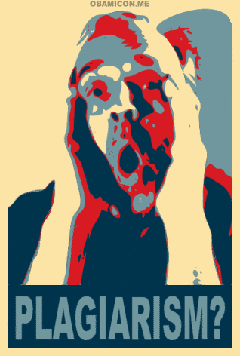 Art or plagiarism?
Art or plagiarism?
The familiar look of the Obama poster can now be yours via a website (see below). This computerized rip-off of Shepard Fairey's signature style fits perfectly into the debate about Mr. Fairey's frequent use of the images of other artists.
The most outspoken critic is Mark Vallen, who co-authored a detailed critique of Fairey's work, calling his approach "brazen, intentional copying of already existing artworks created by others...and then deceiving people by pawning off the counterfeit works as original creations. "
Until I read this article I had no idea how frequently Fairey used images from other sources in his own work with only slight modifications. Vallen shows numerous side-by-side comparisions of Fairey's posters with original source material. Cuban, Chicano, and Black Panther posters have all become part of Fairey's "OBEY" line of prints and clothing.
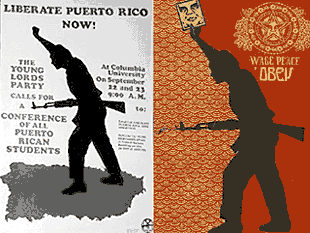 I have mixed feelings about this. There's no doubt that artists throughout history have "borrowed" from the work of others. It's impossible to not repeat ideas, styles and approaches that you've seen and liked. It's not necessarily a bad thing.
I have mixed feelings about this. There's no doubt that artists throughout history have "borrowed" from the work of others. It's impossible to not repeat ideas, styles and approaches that you've seen and liked. It's not necessarily a bad thing.
This isn't just confined to the visual arts. Filmmakers often create scenes or sequences—occasionally entire films—that reproduce work by other directors. Musicians learn "licks" from each other. More recently musical mash-ups combine samples from various songs and artists.
There are obvious questions of how much you use and how closely you copy the original. Whether Fairey crosses that line, and how frequently, is something you'll need to decide for yourself. The examples in Vallen's article seem pretty serious, but they total about a dozen images. A show of Fairey's work at the Institute of Contemporary Art/Boston includes about 200 pieces.
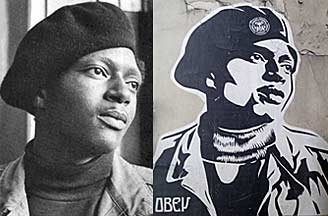 Vallen stresses another point that I find to be more compelling: while liberally borrowing the work of others Fairey can't be bothered to acknowledge the source.
Vallen stresses another point that I find to be more compelling: while liberally borrowing the work of others Fairey can't be bothered to acknowledge the source.
A simple credit to the photographer or artist doesn't seem too much to ask, especially when the connection is so obvious, as in the Black Panther photo by Pirkle Jones that Fairey made into an "OBEY" poster.
Similarly, the iconic Obama poster that made Shepard Fairey famous was based on a photo by Mannie Garcia, as explained in an article by Philadelphia photographer Tom Gralish.
These are important issues to be considered by artists and designers. We live in a time when finding and copying images via the Internet is easier than ever, yet our copyright laws are mostly based on pre-Internet assumptions. There is no quick and easy solution, but the discussion needs to happen.
Vallen's article is a good place to start. It's well documented but a little shrill:
"it’s also not impossible to view Fairey’s work as right-wing in essence, since it largely ransacks leftist history and imagery while the artist laughs all the way to the bank."
"...proof positive of Fairey’s total and complete ignorance of history - which for him exists only as a source of images to be exploited - but because it should make obvious that anyone so ill-informed should not be in the vanguard of today’s political art."
Well here, read it for yourself. Please use the "Comment" link below to add your reaction.
Update—Feb. 2, 2009: The website Supertouch posted an extensive defense of Fairey's work, decrying "vicious and unfounded rumors surrounding the originality of Shepard’s artwork that have been floated online in recent years."
The defense makes two points strongly: First, Fairey is "appropriating" and/or "referencing" the work of others, not plagiarizing it. In doing so he is using a familiar technique of modern art employed by Warhol, Lichtenstein and many others.
Secondly, Fairey is not doing this primarily to make money, and in fact donates substantial amounts to progressive political and social causes.
While I think that this may be evidence that Fairey's heart is in the right place, I'm not sure it's a compelling argument in defense of his artistic methodology. The fact that Supertouch spends so much time on this aspect of the debate may stem from the fact that Fairey is listed as one of the site's authors.
The article sounds like it's written as a defense of a friend falsely accused of a crime. There's nothing wrong with that, it just doesn't help clarify the question of whether Fairey is within his artistic, moral and legal rights to use images as he does.
Update—Feb. 4, 2009: A lengthy, informative if slightly repetitive critique of the Supertouch defense of Fairey by Brian Sherwin, Senior Editor of Myartspace.com. It's well worth the time to read this detailed explanation of copyright law's "Fair Use" exemption. This is the most important piece of the debate, not whether Fairey gives money to liberal causes or is capitalist wolf in sheep's clothing.
Here in a nutshell is a critical concept that Supertouch missed:
Under fair use the general public should know this information [the source of the original image] off hand from their collective knowledge of contemporary society. In other words, they should know without having to buy a book in order to know. The public should be able to look at ‘Cuban Rider’ and say, “Fairey is commenting on the Rene Mederos poster!”. Unfortunately, Shepard Fairey has failed on that crucial aspect of fair use— which is why it seems that he attempts to pass works by others off as his own.
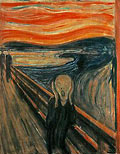 In other words, you probably have at least the vague idea that the graphic I created for the start of this article is based on a famous painting. You might even know that it is The Scream by Edvard Munch.
In other words, you probably have at least the vague idea that the graphic I created for the start of this article is based on a famous painting. You might even know that it is The Scream by Edvard Munch.
Because the painting been reproduced and parodied hundreds of times all over the world, it's reasonable to assume that you won't think I invented the idea. I can claim that this is "fair use" under copyright law.
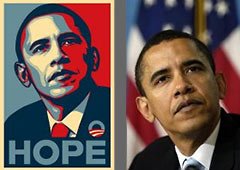 To apply this to Fairey's work, did you have any idea that the famous Obama HOPE poster is based on a photograph by Mannie Garcia?
To apply this to Fairey's work, did you have any idea that the famous Obama HOPE poster is based on a photograph by Mannie Garcia?
I'm guessing not, and that's why Fairey is treading a very thin line in how he appropriates the work of other artists.
OK, now go Obamacize yourself!
And since he's referencing the work of others, why shouldn't we reference his? If you haven't already made yourself into a political poster, be sure to try it at Obamicon.me.
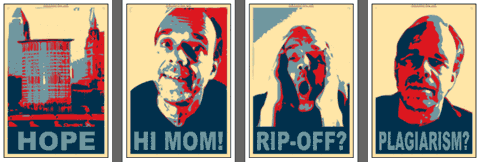 I had lots of fun trying different picture and word combinations as I worked on the graphic for this story.
I had lots of fun trying different picture and word combinations as I worked on the graphic for this story.
Top |
|
![]()